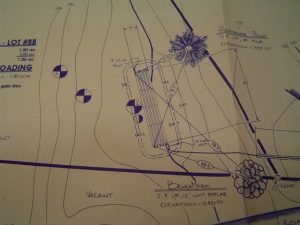A Septic System is Required for Homes Not on a Public Sewage System
By Mark J. Donovan
|
|
If you have plans to build a new home and the property is not connected to the community’s public sewage system you will need to install a private septic system. Prior to installing a septic system you must first have a septic system design completed from a licensed and professional septic system designer.
A private septic system consists of a septic tank and leach field. Sewage exiting your home is directed to the septic holding tank, where the solids settle to the bottom of the tank and the fluids rise to the surface. |
Septic system designs are custom for every house lot due to numerous variable factors. Chief among these factors is how many bedrooms and bathrooms are specified in the house plans. Septic system designs are usually specified as 3 or 4 bedroom septic designs, for example.
| Another important factor that influences a septic system design is the type of soils on the property and how well they lend themselves to drainage. Septic system designers will typically dig a few perk test pits on the property to assess how well the soil drains. With this information they can then determine what type, and how large of a septic system to design. Other factors that influence the septic design include the location of wells, streams and ponds on or near the property.
Once the septic designer has completed a septic system design, it must then go to the local and/or state agencies to be approved. |
 |
Once the septic system design has been approved you can then begin the process of installing your septic system. Only a licensed septic system installer should install the septic system. Once the septic system has been installed the local and state inspectors will need to inspect the septic system to ensure that the septic system complies with the septic system design. Once the septic installation has been approved, the septic tank and leach can then be covered and graded over with soil to complete the septic system installation.
So if you have plans to build a custom home and the land on which it will reside is not on a public sewage system, make sure to have a septic system design completed. Finally, keep in mind that a septic system design can take anywhere from 4-12 weeks to complete and get approved by the town and state. So plan accordingly.
For information on installing a shower pan membrane liner for a ceramic tile shower, see the Shower Pan Membrane Liner Installation eBook from HomeAdditionPlus.com. The Shower Pan Membrane Liner EBook will quickly teach you the step-by-step process for installing the shower pan membrane liner correctly. It includes instructions on framing the shower stall, pouring the pre-slope and shower base mortar, and installing the shower pan membrane liner.
For information on how to tile a custom ceramic tile shower, see the “How to Tile a Custom Ceramic Tile Shower eBook” from HomeAdditionPlus.com. This eBook will quickly provide you with step-by-step instructions on how to measure and install ceramic tile in a shower, including the installation of tile on shower walls, floors and curbs. It provides detailed instructions for every step in the process of tiling a custom ceramic tile shower and is loaded with instructional pictures!
Related Information
Additional Plumbing Resources from Amazon.com
 |
 |
Get Free Bathroom Remodeling Price Quotes with No Obligation!
Fill out our 3-5 minute quick and easy form, and receive a free price quote on a bathroom remodeling project from one of our pre-screened and licensed bathroom remodeling contractors. This process is free and there is no obligation to continue once you receive your bathroom addition price estimate.
